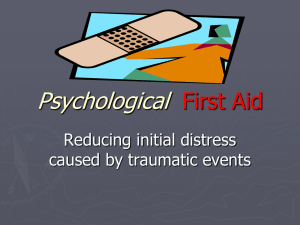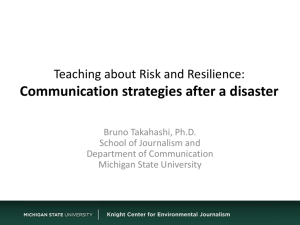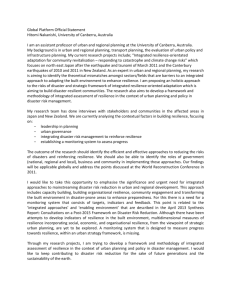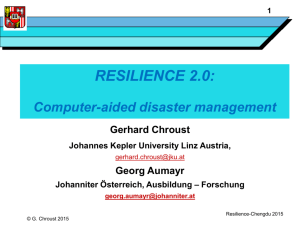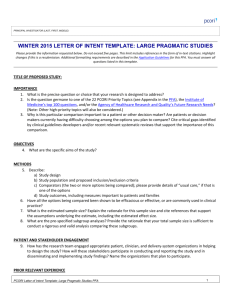Disaster Mental Health
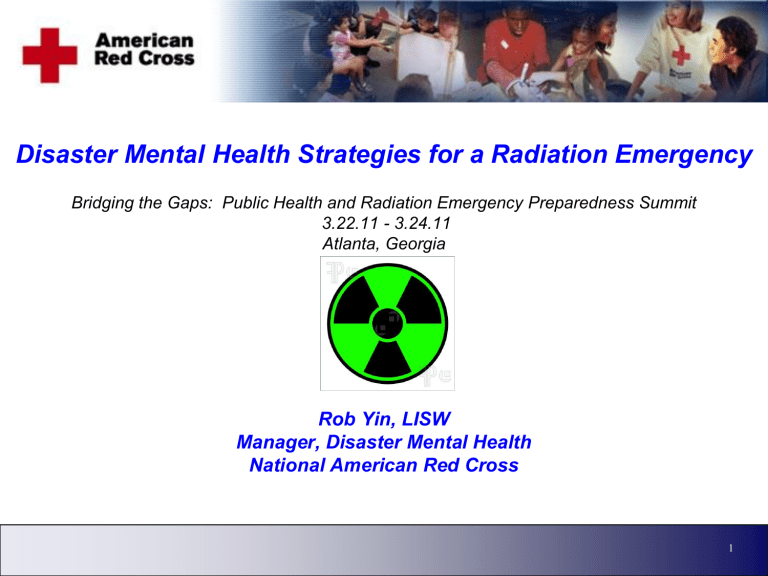
Corporate Strategy
Disaster Mental Health Strategies for a Radiation Emergency
Bridging the Gaps: Public Health and Radiation Emergency Preparedness Summit
3.22.11 - 3.24.11
Atlanta, Georgia
Rob Yin, LISW
Manager, Disaster Mental Health
National American Red Cross
1
Corporate Strategy
American Red Cross Disaster Relief
Humanitarian and independent organization w/
Congressional charter to provide disaster preparedness, response and recovery
Volunteers in 600 chapters respond to 70,000 disasters every year
Disaster mental health (DMH) cadre = 4,000 independentlylicensed, master’s level (or higher)
DMH provides crisis intervention, triage, assessment, mental health surveillance, public
MH messaging and psychological first aid
NTSB MOU with Red Cross to provide support to families after transportation disasters (1996
Aviation Disaster Family Assistance Act)
2
Corporate Strategy
Radiation Event: Unique Stressors and Challenges
Fear, uncertainty and anxiety over short- and long-term health effects
Increased levels of depression, anxiety & somatic symptoms
Demand for physical & mental health services exceeds capacity
Surge in medically unexplained physical symptoms (MUPS; “worried well”)
Critical safety info (e.g., exposure) is difficult to understand and ever-changing
Family members and children are separated
Routines and community support networks are significantly disrupted
Communication systems are overwhelmed
Large number of self-evacuees make movement of response assets difficult
Responders face difficult situations & decisions (helping others vs. own long term health)
Exposed population experiences social stigma
3
Corporate Strategy
Resilience, PFA, Surveillance & Force Health Protection
STATE AND LOCAL HEALTH & MENTAL HEALTH ASSETS
DISASTER MENTAL HEALTH COMMUNITY MEMBERS
ALL DISASTER RESPONDERS
4
Corporate Strategy
COMMUNITY MEMBERS
Planning Phase
Community members taught “neighbor-to-neighbor” PFA and
resilience skills
New Red Cross course: Coping in Today’s World:
Psychological First Aid and Resilience for Families, Friends &
Neighbors
– Pilots in the Gulf region and CA
– Curriculum for school personnel in development
Response/Recovery
Increased resilience and support provided to adults and children during response and recovery
Continued community PFA and resilience training
Family members reconnect via Safe & Well Linking website
(www.redcross.org)
5
ALL DISASTER RESPONDERS
Planning Phase
Disaster PFA training w/ PsySTART triage for all responders
– Emotional support and triage “force multiplier”
– Exposure-based risk factors (“Saw/heard death or serious injury”)
– Highly predictive, especially in contrast to transient symptoms
Force health protection (FHP):
– FHP training for workers, supervisors & leaders
– Coping & resilience-building brochures & messaging
– Pre-deployment screening tool (in development)
– Post-deployment support-guidance and screening tool
– “Just-in-time” stress inoculation training (in development)
Response/Recovery
Increased resilience and quality of work resulting from FHP
Increased PFA support (in-person and telephonic)
Evidence-based triage used for rapid and prioritized referrals
Corporate Strategy
6
Corporate Strategy
DISASTER MENTAL HEALTH
Planning Phase
PFA and resilience training for community members
Disaster PFA (w/ PsySTART triage) training for responders
MH surveillance planning with all MH response partners
Force Health Protection activities (pre-deployment)
Embed w/ media teams & promote broad public MH messaging
– All-hazards (coping with shelter-in-place emergencies)
– Templates for event-specific messaging for later use
Response/Recovery
Just-in-time stress inoculation training (event specific)
Standardized MH surveillance for “common operating picture”
Support reception & post-decontamination sites (cold zone)
PFA & resilience training for community members
Force Health Protection (deployment and post-deployment)
Promote event-specific public MH messaging (social media)
7
Corporate Strategy
STATE & LOCAL HEALTH & MENTAL HEALTH ASSETS
Planning Phase
Engage in mental health surveillance planning and exercising
Train crisis response teams in Disaster PFA and triage
Promote public MH messaging (social media)
Support community PFA and resilience training
Response/Recovery
Mental health surveillance = common operating picture = efficient allocation of MH resources
MH providers receive rapid referrals for those at greatest risk
Public MH messages help people cope & build resilience
Ongoing community PFA and resilience training assists with disaster recovery efforts
8
Corporate Strategy
Resilience, PFA, Surveillance & Force Health Protection
STATE & LOCAL HEALTH AND MENTAL HEALTH ASSETS
Participate in MH surveillance
Receive rapid referrals of high risk clients
Promote timely and appropriate public MH messaging
Support community PFA & resilience training
DISASTER MENTAL HEALTH
Promote Force Health Protection
PsySTART triage/referral
MH surveillance
PFA & resilience training
Embed w/ Public Affairs teams
COMMUNITY MEMBERS
Increased resilience
“Neighbor-to-Neighbor PFA support
ALL DISASTER RESPONDERS
Provide PFA, triage & rapid referral (“force multiplier”)
Increased resilience via force health protection
9
Corporate Strategy
Neighbor-to-Neighbor
PFA & Resilience
Disaster PFA
Psychological First Aid:
Helping Others in Times of Stress
Military Families
PFA & Resilience
10
Corporate Strategy
For More Information:
Rob Yin, LISW
Manager, Disaster Mental Health
National American Red Cross
yinr@usa.redcross.org
(202) – 303 - 4036
Find your local Red Cross chapter: https://www.redcross.org
11


